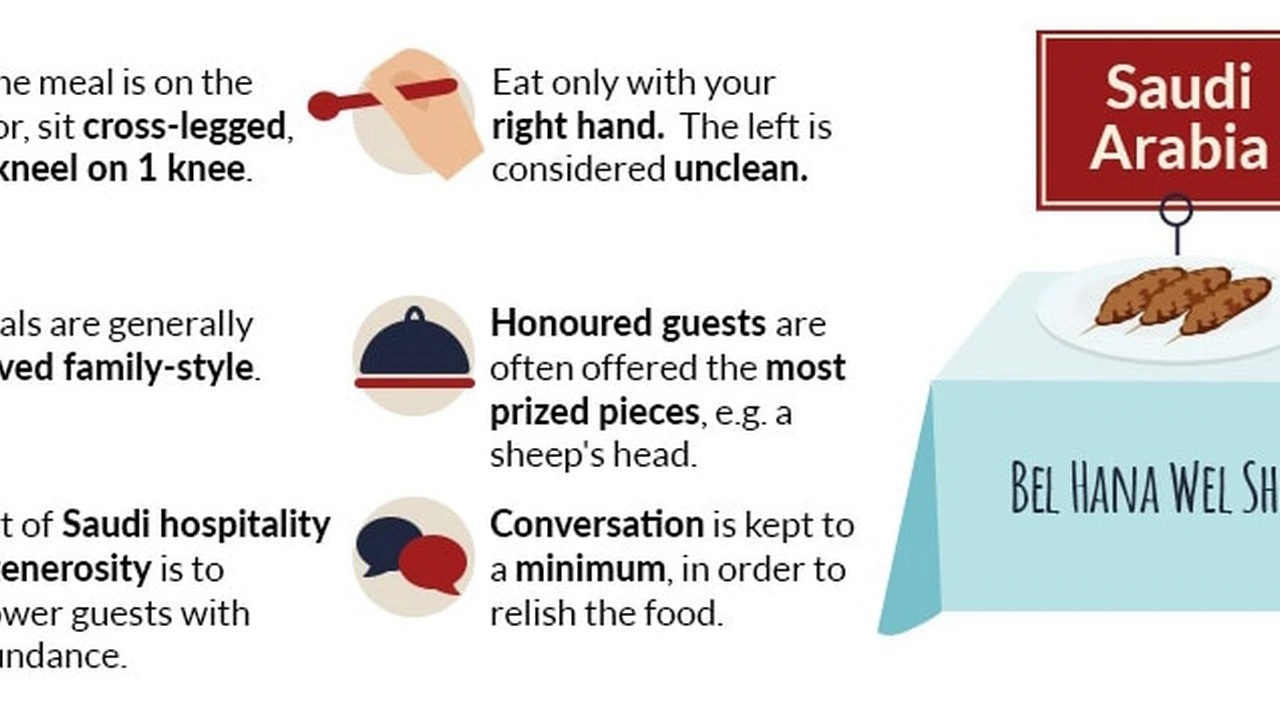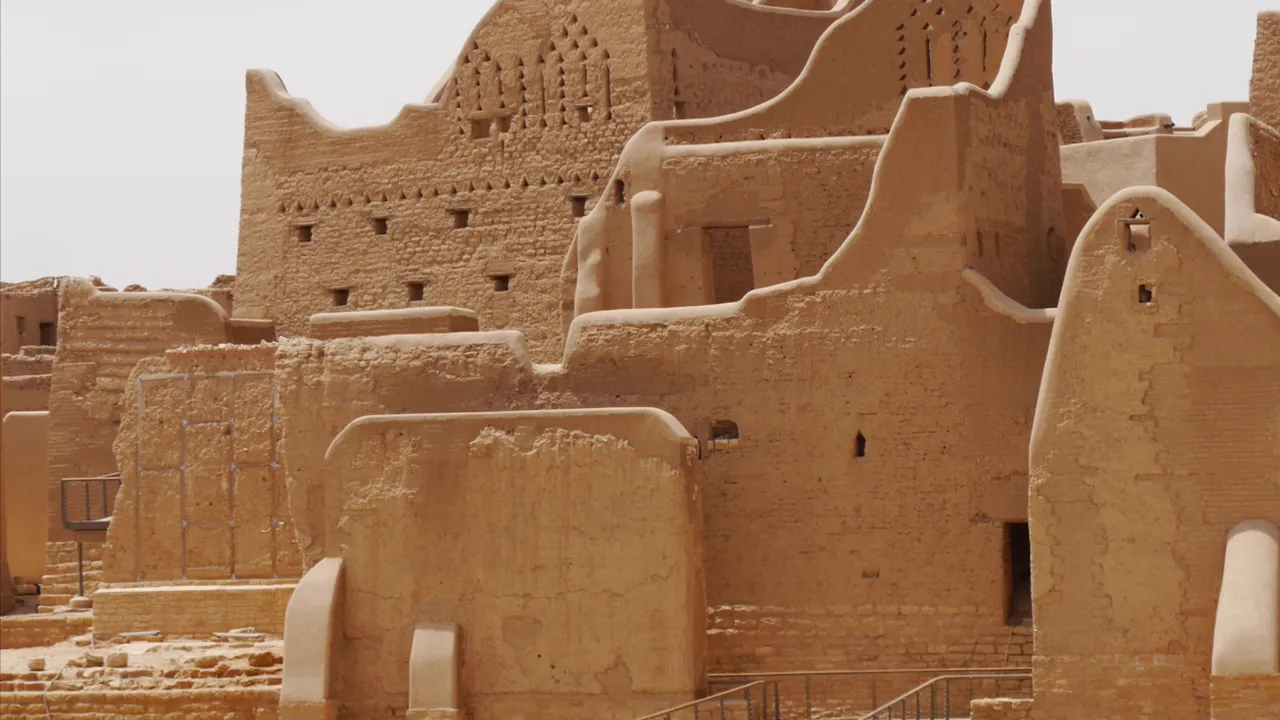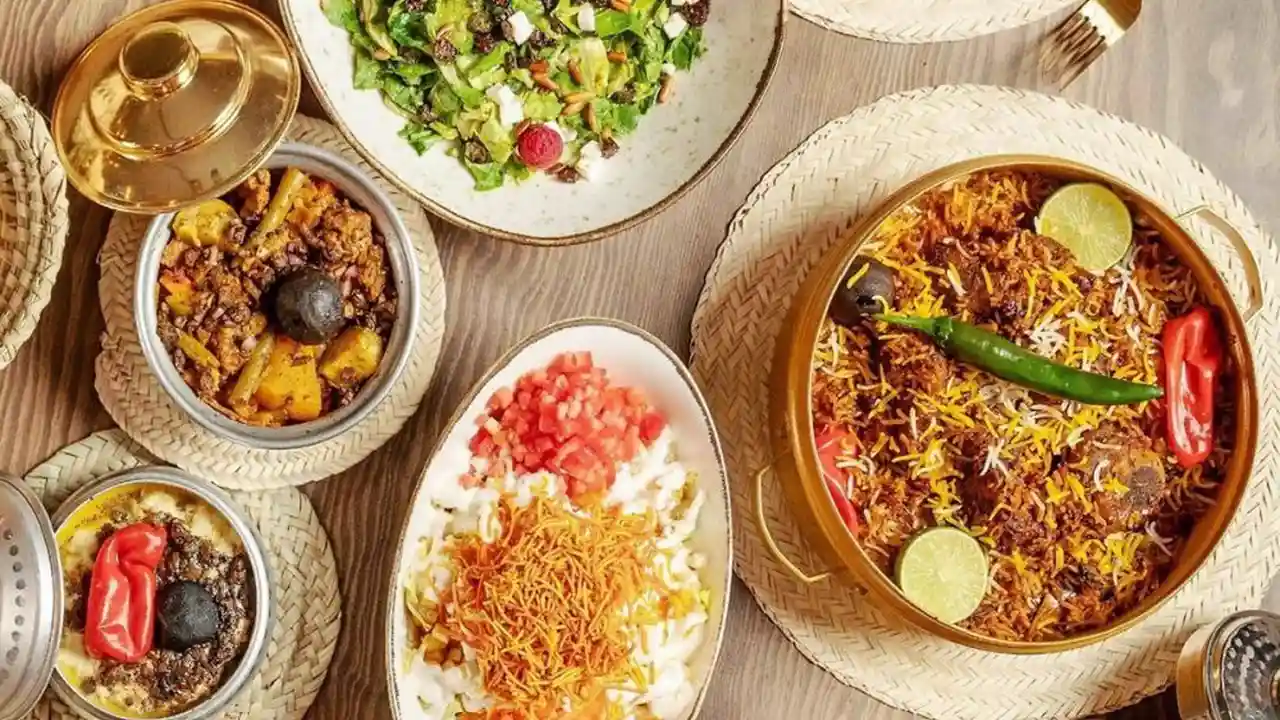
Saudi Arabian Cuisine An Introduction to Flavors
Saudi Arabian cuisine is a fascinating blend of Bedouin traditions, agricultural bounty, and influences from neighboring regions. It's a cuisine deeply rooted in hospitality, generosity, and communal dining. Forget individual plates; meals are often served family-style, encouraging sharing and connection.
The foundation of many Saudi dishes is rice, particularly basmati, which is fragrant and fluffy. Meat, especially lamb and chicken, is also prominent. Spices play a crucial role, with cardamom, cumin, cinnamon, saffron, and black pepper lending warmth and complexity. Dates, a staple of the Arabian Peninsula, provide natural sweetness and energy. And let's not forget coffee – a symbol of Saudi Arabian hospitality, often served with dates and a warm welcome.
Kabsa The National Dish of Saudi Arabia
Kabsa is arguably the national dish of Saudi Arabia. It's a flavorful rice dish typically made with long-grain basmati rice, meat (usually chicken or lamb), vegetables, and a blend of aromatic spices. The meat is often cooked until tender and then added to the rice, along with tomatoes, onions, and peppers. The spice blend varies from region to region, but common ingredients include cardamom, cloves, cinnamon, black pepper, and saffron. Kabsa is often garnished with fried onions, raisins, and almonds.
Product Recommendation: For a truly authentic Kabsa experience at home, consider using a high-quality Kabsa spice blend like the "Al-Areesh Kabsa Spice Mix." It contains a balanced combination of traditional spices, ensuring a flavorful and aromatic dish. You can find it online or at Middle Eastern grocery stores. Pricing: Approximately $8-$12 per jar.
Use Case: Perfect for family gatherings, special occasions, or simply a delicious and satisfying meal.
Mandi A Yemeni Influence on Saudi Tables
Mandi, while originating in Yemen, has become incredibly popular in Saudi Arabia. It's a dish featuring meat (usually lamb or chicken) that's slow-cooked in a tandoor oven or a special underground oven called a "mandi oven." The meat is incredibly tender and flavorful, infused with the smoky aroma of the wood used in the oven. The rice is cooked separately and then served with the meat, along with a flavorful tomato-based sauce called "sahawiq."
Product Recommendation: Replicating the authentic mandi flavor at home can be challenging without a traditional oven. However, you can achieve a similar taste by using a smoker or a slow cooker. Consider using a high-quality wood smoking chips like "Mesquite Wood Chips" for a smoky flavor. Pricing: Approximately $10-$15 per bag.
Use Case: A show-stopping dish for a special occasion or a weekend feast.
Haneeth Slow Cooked Lamb Perfection
Haneeth is another popular dish featuring slow-cooked lamb. The lamb is seasoned with a simple blend of spices and then cooked for hours until it's incredibly tender and falls off the bone. The cooking method varies, but it often involves wrapping the lamb in banana leaves or foil and baking it in a traditional oven or even buried in the ground. Haneeth is often served with rice and a side of vegetables.
Product Recommendation: For preparing Haneeth at home, a good quality Dutch oven is essential. The "Le Creuset Enameled Cast Iron Dutch Oven" provides even heat distribution and helps to retain moisture, resulting in perfectly tender lamb. Pricing: Approximately $300-$400.
Use Case: A comforting and flavorful dish for a cold evening or a special celebration.
Saleeg Creamy Rice Comfort Food
Saleeg is a creamy rice dish that's a staple in the Hejaz region of Saudi Arabia. It's made with short-grain rice, milk, and butter. The rice is cooked in milk until it's soft and creamy, and then butter is added for richness. Saleeg is often served with grilled chicken or lamb. It's a simple but incredibly satisfying dish that's perfect for a comforting meal.
Product Recommendation: Using high-quality short-grain rice is crucial for achieving the right texture for Saleeg. Consider using "Arborio Rice," which is commonly used for risotto, as it has a similar texture and absorbs liquid well. Pricing: Approximately $5-$8 per pound.
Use Case: A comforting and easy-to-make dish for a weeknight meal.
Jareesh A Hearty Wheat Porridge
Jareesh is a hearty and nutritious wheat porridge that's popular throughout Saudi Arabia. It's made with coarsely ground wheat, meat (usually lamb or chicken), and vegetables. The ingredients are cooked together for hours until the wheat is soft and the flavors have melded together. Jareesh is often served with a dollop of sour cream or yogurt.
Product Recommendation: A pressure cooker can significantly reduce the cooking time for Jareesh. The "Instant Pot Duo" is a versatile pressure cooker that can be used for a variety of dishes, including Jareesh. Pricing: Approximately $80-$120.
Use Case: A filling and nutritious meal for a cold day or a hearty breakfast.
Mutabbaq Savory Filled Pancake Delight
Mutabbaq is a savory filled pancake that's a popular street food in Saudi Arabia. It's made with a thin dough that's filled with a mixture of minced meat, eggs, vegetables, and spices. The pancake is then folded and fried until it's golden brown and crispy. Mutabbaq is often served with a side of tahini sauce or hot sauce.
Product Recommendation: A good non-stick skillet is essential for making Mutabbaq. The "T-fal Ultimate Hard Anodized Nonstick Fry Pan" provides even heat distribution and prevents the pancake from sticking. Pricing: Approximately $30-$50.
Use Case: A quick and easy snack or a light meal.
Shawarma The Ubiquitous Street Food
Shawarma is a Middle Eastern classic that's incredibly popular in Saudi Arabia. It's made with thinly sliced meat (usually lamb, chicken, or beef) that's stacked on a vertical rotisserie and slowly roasted. The meat is shaved off and served in a pita bread or wrap, along with vegetables, sauces, and spices. Shawarma is a quick, convenient, and delicious meal that's perfect for on-the-go.
Product Recommendation: While a professional shawarma machine is ideal, you can recreate a similar flavor at home by marinating the meat in a shawarma spice blend and then grilling or pan-frying it. Consider using "Ziyad Shawarma Seasoning" for an authentic taste. Pricing: Approximately $5-$10 per container.
Use Case: A quick and satisfying lunch or dinner.
Falafel Crispy Chickpea Fritters
Falafel is another Middle Eastern staple that's widely enjoyed in Saudi Arabia. It's made with ground chickpeas, herbs, and spices that are formed into small patties and then deep-fried until they're golden brown and crispy. Falafel is often served in a pita bread or wrap, along with vegetables, tahini sauce, and pickles.
Product Recommendation: A good quality food processor is essential for grinding the chickpeas for falafel. The "Cuisinart Food Processor" is a powerful and versatile food processor that can handle a variety of tasks, including grinding chickpeas for falafel. Pricing: Approximately $100-$200.
Use Case: A vegetarian-friendly snack or meal.
Dates The Sweet Fruit of the Desert
Dates are a staple of the Arabian Peninsula and are an integral part of Saudi Arabian cuisine. They're a naturally sweet and nutritious fruit that's packed with energy. Dates are often eaten on their own, but they're also used in a variety of dishes, including desserts, pastries, and even savory dishes.
Product Recommendation: Medjool dates are considered the "king" of dates and are known for their large size, soft texture, and rich flavor. Consider purchasing "Joolies Organic Medjool Dates" for a premium date experience. Pricing: Approximately $15-$20 per pound.
Use Case: A healthy and delicious snack, a natural sweetener for desserts, or a thoughtful gift.
Saudi Coffee A Symbol of Hospitality
Coffee is an integral part of Saudi Arabian culture and a symbol of hospitality. Saudi coffee is traditionally made with lightly roasted Arabica beans and flavored with cardamom. It's served in small, handleless cups and is often accompanied by dates. The pouring and drinking of coffee is a ritualistic process, and it's considered impolite to refuse a cup.
Product Recommendation: For an authentic Saudi coffee experience, consider purchasing a traditional "Dallah" coffee pot. These ornate pots are used to brew and serve Saudi coffee. You can find them at Middle Eastern grocery stores or online. Pricing: Approximately $30-$50.
Use Case: A warm and welcoming gesture for guests, a daily ritual, or a cultural experience.
Kunafa A Sweet Cheese Pastry
Kunafa is a popular Middle Eastern dessert that's made with shredded phyllo dough, cheese, and a sweet syrup. The dough is layered with cheese and then baked until it's golden brown and crispy. The kunafa is then soaked in a sweet syrup flavored with rosewater or orange blossom water. It's a rich and decadent dessert that's perfect for satisfying a sweet tooth.
Product Recommendation: A good quality baking pan is essential for making Kunafa. A springform pan makes it easy to remove the Kunafa without damaging it. The "Nordic Ware Springform Pan" is a durable and reliable option. Pricing: Approximately $20-$30.
Use Case: A special occasion dessert or a sweet treat after a meal.
Exploring Regional Variations in Saudi Cuisine
Saudi Arabian cuisine is diverse and varies from region to region. Coastal regions, for example, tend to feature more seafood dishes, while inland regions rely more on meat and grains. The spices and cooking methods also vary, reflecting the unique culinary traditions of each region. Exploring these regional variations is a delicious way to experience the richness and diversity of Saudi Arabian cuisine.
:max_bytes(150000):strip_icc()/277019-baked-pork-chops-with-cream-of-mushroom-soup-DDMFS-beauty-4x3-BG-7505-5762b731cf30447d9cbbbbbf387beafa.jpg)






